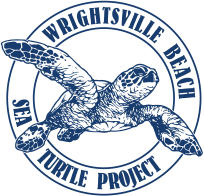During the months of May, June, July and August, loggerhead sea turtles crawl out of the Atlantic Ocean to lay their nests on the shores of Wrightsville Beach. A loggerhead mother uses her rear flippers to dig a nest chamber in the sand, then deposits approximately 100 round, white leathery eggs. The mother turtle then covers the nest chamber, concealing it with sand, and crawls back to sea, never to meet her offspring. The eggs incubate for approximately 45-70 days before hatchlings emerge.
In the state of North Carolina, all sea turtle nests remain “in situ,” meaning the nests are left in place and not relocated to a nursery. If a nest is laid below the high tide line, it is relocated to the nearest safe spot above the high tide line.
Please Note: Nest Hatching Times
We receive many emails inquiring about when sea turtle nests are expected to hatch. We cannot tell you this, not because we are withholding information, but because there is no way to know. Some nests hatch as quickly as after 45 days of incubation and others take as long as 72 days. Much like when a human mother is expecting, there is a “due date” but babies emerge on their own time, and the actual birth date can, and often does, occur about 2 weeks before or after the due date. Additionally, sea turtle nests hatch at night, and hatchlings can emerge at any time between dusk and dawn.



